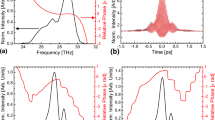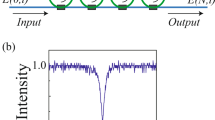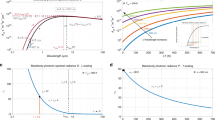Abstract
It is widely accepted that a signal bandlimited by σ cannot oscillate at higher frequencies. The phenomenon of superoscillation provides a refutation of that quite general belief. Temporal superoscillations have been rarely demonstrated and are mostly treated as a mathematical curiosity. In the present article we demonstrate experimentally for the first time to our best knowledge, the transmission of superoscillating signals through commercial low pass filters. The experimental system used for the demonstration is described, providing the insight into the transmission of superoscillations, or super-narrow pulses. Thus, while the phenomenon may seem rather esoteric, a very simple system is used for our demonstration.
Similar content being viewed by others
Introduction
We start our discussion, rather unconventionally, by presenting some simple yet intriguing experimental results, even before any formal introduction. In Fig. 1 we present a schematic description of our experimental setup. It consists of an arbitrary shape waveform generator (Agilent 33500B), a low pass filter (LTC1569-6) and an oscilloscope (DSO-X 3024 A). All are off the shelf commercial not oversophisticated components. In Fig. 2 we show the transmission characteristics of our low pass filter.
In Fig. 3 we show two almost identical pulses. The pulses are fractions of two different signals, generated by the arbitrary waveform generator. The two signals are then transmitted through the low pass filter described in Fig. 2. A very natural expectation is that both pulses will not be transmitted as is but will be considerably broadened to respect the limitations imposed by the low pass filter. The shape and duration of both pulses seem to indicate that both input signals contain frequencies above the effective band limit of the filter. Indeed we see in Fig. 4a the expected generic transmission. The transmitted pulse (in red) is broadened considerably relative to the input pulse (in blue) due to the loss of the high frequency components. In Fig. 4b we see that the second, almost identical pulse, after being transmitted through the same filter (in red) is almost not broadened at all relative to the input signal (in blue).The input pulses are relatively not noisy. The output pulses, on the other hand, are rather noisy. The output pulses depicted in Fig. 4 are actually polynomial fits to the noisy data recorded by the oscilloscope.
The difference between the two cases cannot be but in the way in which the two pulses are complemented to generate the two longer signals. Thus, not only the rise and fall time of the pulse are relevant to its transmission but also features of the signal outside the pulse itself!!. The transmission shown in Fig. 4a is the generic case, which is typical of the overwhelming majority of ways in which the pulse is complemented to the longer signal. The transmission shown in Fig. 4b is an extremely rare case, where the duration of the transmitted pulse is almost unaffected by the low pass filter. The blue and red curves in Fig. 4 correspond to the output and input pulses respectively.
The input pulses in Fig. 3 are almost identical but the way in which the signal is complemented is quite different. The input signal, corresponding to the output pulse in Fig. 4a, is a periodic pulse with period 2π∕σ defined by:
with nσ the highest frequency component. The input signal, corresponding to the output pulse in Fig. 4b is given by:
where mσ grazes the effective band limit of the low pass filter. The functions \({h}_{n}^{m}(l,\sigma t)\) are required to obey the following: (a)Each of those function are band limited by the filter bandwidth. (b)Within the width of fn(t), \({h}_{n}^{m}(l,\sigma t)\) approximates eilσt to a required accuracy. By construction, \({g}_{n}^{m}(t)\) is limited within the transmission band of the low pass filter and is made to adhere to fn(t) at small values of σt. The functions \({h}_{n}^{m}(l,\sigma t)\), are band limited yet oscillate locally at a frequency higher than the band limit. Such signals are called superoscillations. Consequently, the highest frequency component present in \({g}_{n}^{m}(t)\) is only mσ.
Theory, Experimental Results and Discussion
To understand the concept of superoscillation, consider a band limited signal-it could be optical, electrical or acoustic, it does not really matter. Although the signal will have a power spectrum that spans a certain frequency range, an analysis of the signal over particular time intervals might show, however, local oscillations with a frequency outside the frequency range of the signal. These are called superoscillations. A number of examples have been given for such signals1,2,3,4 with suggested applications in various fields such as signal processing5,6,7,8 and quantum mechanics1,3,9,10. The concept of superoscillations is also most useful in optics, where it is intimately related to super resolution11,12,13,14,15,16. In contrast to what is going on in the other fields mentioned, where the application of superoscillations is more a theoretical study of the possibilities, the application to optics is in a much more advanced phase of practical experimental study17,18,19,20,21,22. The present more practical application of superoscillations in optics is based, however, (with the exception of ref. 18) on spatial structures on scales smaller than the wave length of the light interacting with those structures. This results in beams narrower than allowed by the Rayleigh-Abbe diffraction limit . The phenomenon of superoscillation is very exciting and seems to suggest many possible and beautiful applications. Yet the applications are still quite limited. The reason is that in a sense, the widely accepted lore, that frequencies higher than the band limit cannot be observed even locally in a band limited signal, is not entirely false. The fact is that superoscillations are possible but they come at a high price. It is well known that the superoscillations exist in limited time intervals and that the amplitude of the superoscillations is extremely small compared to typical values of the amplitude in the non-superoscillating parts of the signal. The ratio between the two depends on the ratio of superoscillation frequency to the band limit frequency but it depends also much stronger (exponentially) on the number of superoscillations in those intervals23 and is also sensitive to noise24,25. This fact and the dynamic range if the oscilloscope, limits the range of band limited functions \({h}_{n}^{m}(l,\sigma t)\) that can be used to construct the superoscillatory pulse in Fig. 5.
The signal described by the red curve in Fig. 5 is based on an analytic expression given first by Aharonov, Popescu and Rohrlich1:
It is well known that fk(vt, ω/v) ≈ eiωt for \(vt < \sqrt{\varepsilon k/[{(\omega /v)}^{2}-1]}\), where ε is the allowed tolerance, regardless of the fact that it is easily verified that fk(vt, ω/v) is band limited by v and that ω/v may be arbitrarily larger than 12.This is an example of a superoscillating signal. It is band limited by v yet for arbitrary long time, depending on εk, it oscillates with a frequency ω, higher than the band limit. We chose:
The red curve is obtained using \({g}_{n}^{m}(t)\) with n = 5 and m = 2. Figs. 3 and 4 become now very clear. The signal \({g}_{5}^{2}(t)\) is obtained by replacing in f5(t) the components with frequencies above the filter band limit (40kHz) by the corresponding APR signals, which superoscillate locally near the origin with the same frequency. This explains why the signals \({g}_{5}^{2}(t)\) and f5(t) are very close to one another in the vicinity of the origin, as seen in Fig. 3. Next, it is clear from equation (1) that the constituent frequencies of f5(t) are of the form 20nkHz, with n = 0,...,5, Thus, the frequencies 60, 80 and 100kHz, are removed by the low pass filter and the output signal is broadened (Fig. 4a). On the other hand, all the real constituent frequencies of \({g}_{5}^{2}(t)\) are of the form 8nkHz, with n = 0, …, 5, and thus below the effective band limit. Thus, the necessary condition for the transmission of all frequency components is fulfilled. This however, is not yet sufficient for the central pulse to pass the filter only slightly distorted. The dependence of the group delay of the filter on frequency (Fig. 2), at frequencies below the band limit, is of crucial importance for that. Fortunately, the nonlinearity of the group delay vs. frequency of the filter in the relevant frequency range (Fig. 2), is not large enough to distort the transmitted pulse significantly.
Our Explanations above rely on Eqs. (1)–(3), which give the form of the idealized signals. The real input signals must be different due to the finite duration of the signal and might affect our arguments above. Therefore, we present in Fig. 6 Fourier transforms of the two time restricted signals corresponding to the input signals f5(t) and \({g}_{5}^{2}(t)\). The Fourier transform of the realization of f5(t) exhibits six distinct peaks which are to a good approximation located at 20nkHz and are more or less of the same height. A lot of weight exists at frequencies above the band limit. Thus, the output signal is broadened as discussed above. The Fourier transform of \({g}_{5}^{2}(t)\) is mostly concentrated below 40kHz. This is consistent, of course, with the fact that the output pulse is not broadened. As mentioned above this would not have sufficed for the approximate shape recovery of the central pulse.
Fourier transform of transmitted signals where (a,b) corresponds to f5(t) and \({g}_{5}^{2}(t)\) respectively. Note that the Fourier transform in (b) seems to miss two frequencies. This is not the case but may look so because on the right hand side of Eq. (2) not all the frequency components appear with the same weight,contrary to the right hand side of Eq. (1).
It is important to note, that we could have chosen on the right hand side of Eq. (4) other analytic superoscillating26,27,28,29 signals instead of the APR signals2 to obtain similar results. In fact, it could be expected that using instead the APR signals, yield optimized signals23 would result in better looking input superoscillating pulses. As can be seen, however, from the above it is not necessary for our demonstration. Off the shelf equipment and the very convenient APR functions are sufficient to make our point. Namely, it is actually possible to pass through a low pass filter “too narrow” pulses and it does not involve a high level of sophistication.
Impact of phase variations on super oscillatory signal
Since superoscillation is a delicate destructive interference phenomenon, it is important to understand the sensitivity of our results to random phase shifts. First, it is clear that in the pulse \({g}_{n}^{m}(t)\), the contribution most sensitive to random phase shifts is fk(mσt, n/m). Its general form (which includes also other superoscillating signals) is given by:
Introducing random phase shifts results in:
We assume that the ϕj’s are not correlated, that the average of ϕj, < ϕj > = 0, \( < {\phi }_{j}^{2} > =\delta \ll 1\) and therefore \( < exp(i{\phi }_{j}) > =1-\frac{1}{2}\delta \). We will get the idea of how small δ should be by taking two averages. The first average is just
Thus, for small mσt the average still approximates einσt, consider next:
Thus the precise condition on δ, that ensure that the random phase shifts do not destroy the local high frequency of the superoscillation is
which is considerably more stringent than just δ ≪ 1
Summary
We have presented a generic way of constructing interesting super- narrow structures, which include super positions of pure superoscillations (A different, quite interesting way of fitting a general polynomial over a finite range by superoscillating function had been presented in30). We have considered the transmission of electrical signals of that nature through low pass filters, relative to which those structures are "too narrow” . We have demonstrated the possibility of transmission of such narrow structures in the lab using rather basic equipment. We showed that the faithful transmission can be achieved with real world components even though strict superoscillation is only a mathematical idealization, We have also obtained the sensitivity of superoscillations to random phase shifts of the constituent Fourier components. We expect to come back to the fascinating phenomenon of superoscillation in the very near future. It seems to open many interesting directions of research31,32.
References
Aharonov, Y., Albert, D. Z. & Vaidman, L. How the result of a measurement of a component of the spin of a spin 1/2 particle can turn out to be 100? Physical review letters 60, 1351–4 (1988).
Aharonov, Y., Popescu, S. & Rohrlich, D. How can an infra-red photon behave as a gamma ray? Tel-Aviv University Preprint TAUP (1990).
Berry, M. V. Evanescent and real waves in quantum billiards and Gaussian beams. J. Phys. A: Math. Gen. 27, 391–8 (1994a).
Kempf, A. Black holes, bandwidths and Beethoven. J. Math. Phys 41, 2360–74 (2000).
Ferreira, P. J. S. G. & Kempf., A. The energy expense of superoscillations. Proc. EUSIPCO-2002 XI Eur. Signal Process. Conf 2, 347–50 (2002).
Ferreira, P. J. S. G. & Kempf, A. Superoscillations: faster than the Nyquist rate. IEEE Trans. Signal Process. 54, 3732–40 (2006).
Lee, D. G. & Ferreira, P. J. S. G. Direct construction of superoscillations. IEEE Trans. Signal Process. 62, 3125–34 (2014a).
Lee, D. G. & Ferreira, P. J. S. G. Superoscillations of prescribed amplitude and derivative. IEEE Trans. Signal Process. 62, 3371–8 (2014b).
Berry, M. V. Faster than fourier in quantum coherence and reality. Celebration of The 60th Birthday of Yakir Aharonov 55–65 (1994b).
Berry, M. V. & Popescu, S. Evolution of quantum superoscillations and optical superresolutions without evanescent waves. J. Phys. A: Math. Gen 39, 6965–6977 (2006).
Huang, F. M. & Zheludev, N. I. Super- resolution without evanescent waves. Nano Lett. 9, 1249–54 (2009).
Lindberg, J. Mathematical concepts of optical superresolution. Journal of Optics 14, 08, https://doi.org/10.1088/2040-8978/14/8/083001 (2012).
Rogers, E. T. F et al. A super-oscillatory lens optical microscope for subwavelength imaging. Nature materials 11(432–5), 03, https://doi.org/10.1038/nmat3280 (2012).
Zheludev, N. I. What diffraction limit. Nat. Mater. 7, 420–422 (2008).
Yuan, G. et al. Planar super-oscillatory lens for sub-diffraction optical needles at violet wavelengths. In Scientific reports (2014).
Makris K. G. & Psaltis D. Superoscillatory diffraction-free beams. Opt. Lett. 360(22), 4335–4337, https://doi.org/10.1364/OL.36.004335, http://ol.osa.org/abstract.cfm?URI=ol-36-22-4335 (Nov 2011).
Eliezer, Y. & Bahabad, A. Super-oscillating airy pattern. ACS Photonics 3, 05 (2016).
Eliezer, Y., Hareli, L., Lobachinsky, L., Froim, S. & Bahabad, A. Breaking the temporal resolution limit by superoscillating optical beats. Phys. Rev. Lett. 119, 043903, https://doi.org/10.1103/PhysRevLett.119.043903 (Jul 2017).
Greenfield E. et al. Experimental generation of arbitrarily shaped diffractionless superoscillatory optical beams. Opt. Express, 210(11), 13425–13435, https://doi.org/10.1364/OE.21.013425, http://www.opticsexpress.org/abstract.cfm?URI=oe-21-11-13425 (Jun 2013).
Remez, R. & Arie, A. Super-narrow frequency conversion. Optica, 20(5), 472–475, https://doi.org/10.1364/OPTICA.2.000472, http://www.osapublishing.org/optica/abstract.cfm?URI=optica-2-5-472 (May 2015).
Eliezer, Y. & Bahabad, A. Super-transmission: the delivery of superoscillations through the absorbing resonance of a dielectric medium. Opt. Express, 220(25), 31212–31226, https://doi.org/10.1364/OE.22.031212, http://www.opticsexpress.org/abstract.cfm?URI=oe-22-25-31212 (Dec 2014).
Singh, K. B. et al. Particle manipulation beyond the diffraction limit using structured super-oscillating light beams. Light: Science & Applications, 6, e17050 EP –, Sep 2017, https://doi.org/10.1038/lsa.2017.50 Original Article.
Katzav, E. & Schwartz, M. Yield-optimized superoscillations. IEEE Trans. on Signal Processing 61(3113-8), 09 (2012).
Berry, M. V. Suppression of superoscillations by noise. Journal of Physics A: Mathematical and Theoretical, 500(2), 025003, http://stacks.iop.org/1751-8121/50/i=2/a=025003 (2017).
Katzav, E., Perlsman, E. & Schwartz, M. Yield statistics of interpolated superoscillations. J. Phys. A: Math. Theor, 500(2), 025001, http://stacks.iop.org/1751-8121/50/i=2/a=025001 (2017).
Leilee, C. & Achim, K. New methods for creating superoscillations. Journal of Physics A: Mathematical and Theoretical 490(50), 505203, https://doi.org/10.1088/1751-8113/49/50/505203 (nov 2016).
Berry, M. V. Representing superoscillations and narrow gaussians with elementary functions. Milan Journal of Mathematics 84, 10, https://doi.org/10.1007/s00032-016-0256-3 (2016).
Aharonov, Y., Colombo, F., Sabadini, I., Struppa, D. C. & Tollaksen, J. Superoscillating sequences in several variables. Journal of Fourier Analysis and Applications, 220(4), 751–767 ISSN, 1531–5851, https://doi.org/10.1007/s00041-015-9436-8 (Aug 2016).
Matt K. Smith & Gregory J. Gbur. Construction of arbitrary vortex and superoscillatory fields. Opt. Lett. 410(21), 4979–4982, https://doi.org/10.1364/OL.41.004979, http://ol.osa.org/abstract.cfm?URI=ol-41-21-4979 (Nov 2016).
Chermonos, I. & Fikioris, G. Superoscillations with arbitrary polynomial shape. Journal of Physics A: Mathematical and Theoretical 480(26), 265204, https://doi.org/10.1088/1751-8113/48/26/265204 (jun 2015).
Fedorov, F. I. Theory of elastic waves in crystals, volume 0. Plenum Press, New York (1968).
Mansuripur, M. & Jakobsen, P. K. An approach to constructing super oscillatory functions. Journal of Physics A: Mathematical and Theoretical 520(30), 305202, https://doi.org/10.1088/1751-8121/ab27de (jul 2019).
Acknowledgements
We would like to thank Dr. B.I. Lembrikov for critical reading of the manuscript.
Author information
Authors and Affiliations
Contributions
All authors contributed equally to the ideas,results analysis and the main manuscript text. Experiments were performed by Y. Ben Ezra and S. Zarkovsky, all figures were done by S. Zarkovsky. All authors reviewed the manuscript.
Corresponding author
Ethics declarations
Competing interest
There is no competing interest.
Additional information
Publisher’s note Springer Nature remains neutral with regard to jurisdictional claims in published maps and institutional affiliations.
Rights and permissions
Open Access This article is licensed under a Creative Commons Attribution 4.0 International License, which permits use, sharing, adaptation, distribution and reproduction in any medium or format, as long as you give appropriate credit to the original author(s) and the source, provide a link to the Creative Commons license, and indicate if changes were made. The images or other third party material in this article are included in the article’s Creative Commons license, unless indicated otherwise in a credit line to the material. If material is not included in the article’s Creative Commons license and your intended use is not permitted by statutory regulation or exceeds the permitted use, you will need to obtain permission directly from the copyright holder. To view a copy of this license, visit http://creativecommons.org/licenses/by/4.0/.
About this article
Cite this article
Zarkovsky, S., Ben-Ezra, Y. & Schwartz, M. Transmission of Superoscillations. Sci Rep 10, 5893 (2020). https://doi.org/10.1038/s41598-020-62018-7
Received:
Accepted:
Published:
DOI: https://doi.org/10.1038/s41598-020-62018-7
This article is cited by
-
Optical superoscillation technologies beyond the diffraction limit
Nature Reviews Physics (2021)
Comments
By submitting a comment you agree to abide by our Terms and Community Guidelines. If you find something abusive or that does not comply with our terms or guidelines please flag it as inappropriate.









